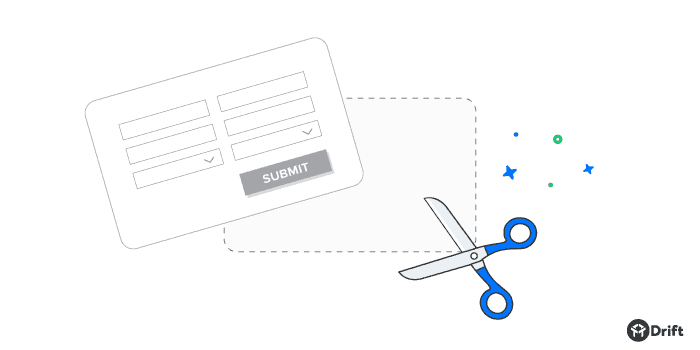
We’ve been talking about it for more than a year now:
Getting rid of lead forms.
It’s become a bit of an obsession here at Drift, both for the marketing team and our product team. And here’s why:
The traditional, forms-based buying process is broken.
It’s too complex, it’s too slow, it’s too outdated, and — most significantly for your sales teams — it doesn’t produce great results.
So, why are so many companies still using lead capture forms as their primary method for generating leads?
Easy: Because so far there hasn’t been a viable alternative.
Only now there is.
Here are four reasons why you should replace your lead forms with messaging (plus some tactical advice for making it happen).
1. Messaging removes complexity from the buying process
Here’s what the typical B2B buying process looks like today:

Potential customers land on your website, they fill out a form, and then they enter the maze.
Companies use marketing automation to “nurture” new leads with email after email, and if those leads continue to show interest and perform the right actions, they get qualified. Then they get to have a meeting with a sales rep, or see a demo, etc.
Of course, that’s assuming a company follows up with a lead at all.
In our lead management survey that looked at the response times of 433 B2B companies, we found that 55% (240 companies) took 5+ days to respond to new leads or they never even responded.
What did those 240 companies with the slowest response time have in common? They were all using lead capture forms. And they were all relying on modes of communication (email and phone) that are outdated.
In a world where 9 out of 10 people want to be able to use messaging to talk to businesses, only 14% of the companies we looked at in our survey were using it.
Instead of making potential customers rely on forms and follow-up emails, you can now simplify the buying process for them with messaging.
Here’s how it works.

With a messaging platform like Drift, there’s no need for potential customers to fill out forms because you (or a bot) can simply ask them for an email address during a conversation. And once an email is entered, it automatically gets saved as a new contact.
You can even create lead capture campaigns that target specific pages of your site and/or certain types of visitors with customized messages and calendar invites.
From a potential buyer’s perspective, the experience is seamless. Instead of jumping between phone calls and emails and having to find open calendar slots for booking demos, with messaging all of those things can happen in one place.
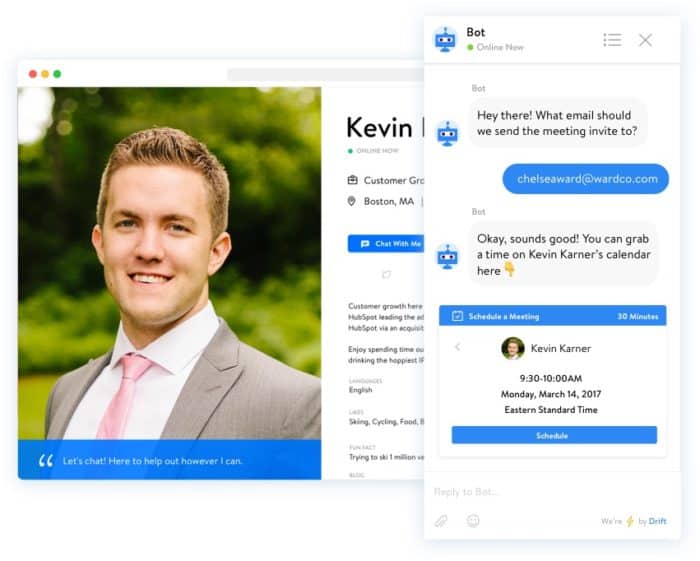
Specifically, with Drift, salespeople can integrate their Google Calendars, which makes booking meetings a breeze. Drift takes care of picking a time to meet, confirming the meeting, and sending calendar invites to both sides.
As a marketer or salesperson having a conversation with someone in Drift, all you have to do is click the calendar icon and select the calendar you want to share.
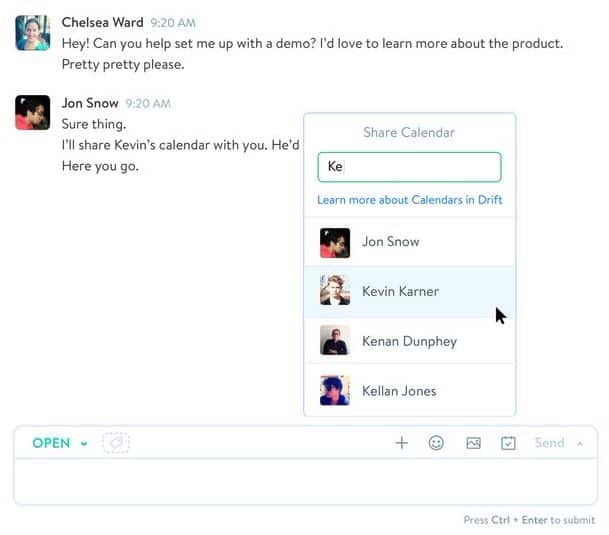
2. Messaging happens in real-time.
By making people fill out forms, you’re missing the opportunity to engage with those people when they’re at their most interested: While they’re live on your website.
Think about it. People are taking the time to visit your website, out of the 1 billion+ websites on the internet.
But instead of welcoming these website visitors, instead of reaching out right at the moment of highest intent and saying, “Hey, can I help you with anything?” we’ve been telling these potential customers to get lost.
By putting up lead capture forms (e.g. “Give us your contact information and someone will follow up with you later”), we’ve been putting our own needs ahead of the needs of our future customers.
The brick-and-mortar equivalent would be doing a bunch of promotion to get shoppers into your store, but once they’re actually inside you refuse to talk to them. And if they’re interested in buying something you make them fill out a form first. Then you send them a postcard a week later…
I think we can all agree that this is an unnecessarily slow process.
By replacing forms with messaging, every stage of your sales process can happen in real-time, from capturing leads, to qualifying leads, to booking meetings and demos, to closing deals.
Here’s how it works.

Step 1: Capture
Use live chat to capture leads while they’re live on your website. If your website receives lots of traffic, we recommend starting out by putting live chat on your highest-intent pages first (e.g. your pricing page). For sites with low traffic, we recommend putting live chat on every page of your site.
Step 2: Qualify
With Drift, there’s no need to send out email blasts and make a million phone calls in order to qualify new leads. Instead, our LeadBot can do that for you in real-time. All you need to do is take the qualifying questions your sales team currently asks and turn them into a script for LeadBot — just like RapidMiner did in the example below.
Pro tip from the Drift team: Always have clear objectives when it comes to writing your scripts. We try to follow this structure to make sure we’re always staying on point:
- Question 1: What? (What brought you here?)
- Question 2: Who? (Who are you? What company do you represent?)
- Question 3: How? (How can I help you use our product?)
- CTA (book a demo, leave an email, start a trial, engage with human)
(For more advice on writing questions for LeadBot, check out this help doc.)
Step 3: Connect
Once a lead has been qualified, there’s no need to wait: Sales reps can reach out instantly and chat. And with intelligent routing, you can even have leads routed to the right reps automatically (more on that next).
3. Messaging is intelligent
Imagine there’s a lead visiting your website’s pricing page.
Using messaging, the sales rep who owns that lead can get a push notification as soon as that happens and immediately start up a conversation.

Alternatively, if it’s the middle of the night and all your sales reps are asleep, you can build a LeadBot campaign that triggers based on the same criteria.
Already we’re talking about technology that lead forms (even the “dynamic” ones) can’t compete with. But messaging can also perform several other intelligent tasks.
For example, our DriftBot can intelligently route incoming chats to the right people/departments in your company.
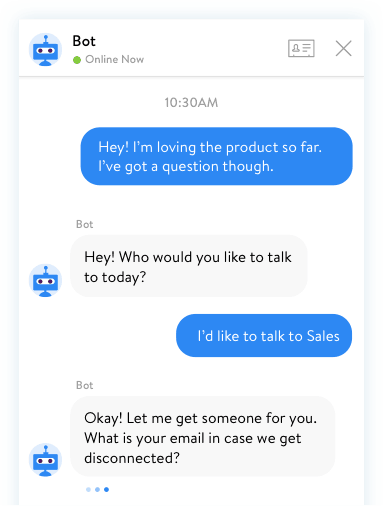
It can also route chats to specific sales reps based on the territories they’re responsible for.
Ultimately, we’re trying to harness the power of artificial intelligence (AI) and chatbots to make it easier for your sales reps and BDRs to sell.
Here’s how it works.
Getting started with intelligent messaging can be as simple as naming your bot, uploading an icon, and assigning some basic routing rules.
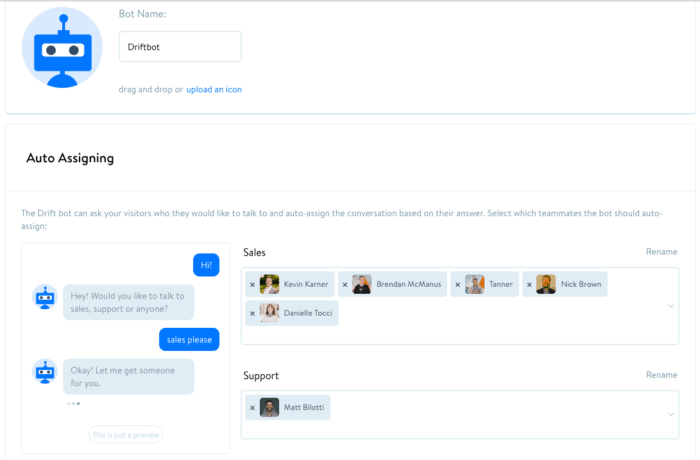
In order to route incoming chats to sales reps based on geography/sales territory, Drift looks at the IP addresses of your visitors to figure out their locations. It’s your job to create a conversation routing rule for each territory so the right reps get matched up with the right leads.
For larger sales teams, where you have multiple reps operating in a single territory, you can either set your rule so that every rep in that territory gets pulled into every conversation, or you can have chats get assigned to individual reps on a rotating basis. (We typically stick with the latter approach).

Of course, this is just a small sampling of how intelligent messaging can work for your sales team. Everyday there seems to be a new innovation, or a new use case.
One of the coolest ones I’ve seen recently: Segment’s VP of Growth created a targeted messaging campaign that uses IP address → domain matching (powered by Clearbit) to surface the names of companies that anonymous visitors work at.
That way, if Segment’s lead-scoring model shows that a company is a good fit, employees of that company can see a personalized message when they drop by the Segment website.

4. Messaging can improve your bottom-line
Given all the advantages messaging has over lead capture forms — it removes complexity, it works in real-time, and it’s intelligent — it’s not surprising that adding messaging to your website can give your business a serious boost.
Remember Guillaume, Segment’s VP of Growth, from the previous section? He recently told us that Drift is now Segment’s number one source of qualified opportunities, and year-to-date Drift has been the strongest contributor to their growth in 2017.
Then there’s Neil Parker, VP of Marketing at RewardStream. He recently told us that within the first 45 days using Drift, 30% of RewardStream’s leads that converted into meetings and demos originated from Drift.
And our customers aren’t alone in experiencing these kinds of results. At Drift, our own salespeople are seeing the same thing. Case in point: Meet our sales rep Tanner, who was able to book 12 meetings and close 3 deals in his first week using Drift.

Overall, the average ROI of using a paid live chat service for sales-focused activities is 305%, with a payback period of six months (according to a study from Forrester).
Here’s how it works.
Alright, it’s time for me to come clean.
Throughout this entire post I’ve been talking about replacing lead forms with messaging. But the reality is that you don’t need to get rid of your forms in order to drive results with messaging.
While getting rid of lead forms is the option we went with, a second option is to simply add messaging to your website as a “second net.” Keep everything else the same, and just open up messaging as a new channel for selling on your website.
The bottom line: Real-time selling™ is the future of sales.
Chances are, there are people visiting your site right now who have questions about your product.
By putting Drift on your site, you’re putting up a big “open for business” sign, and you’re letting people know you’re around to help them.



